Fettuccine Alfredo
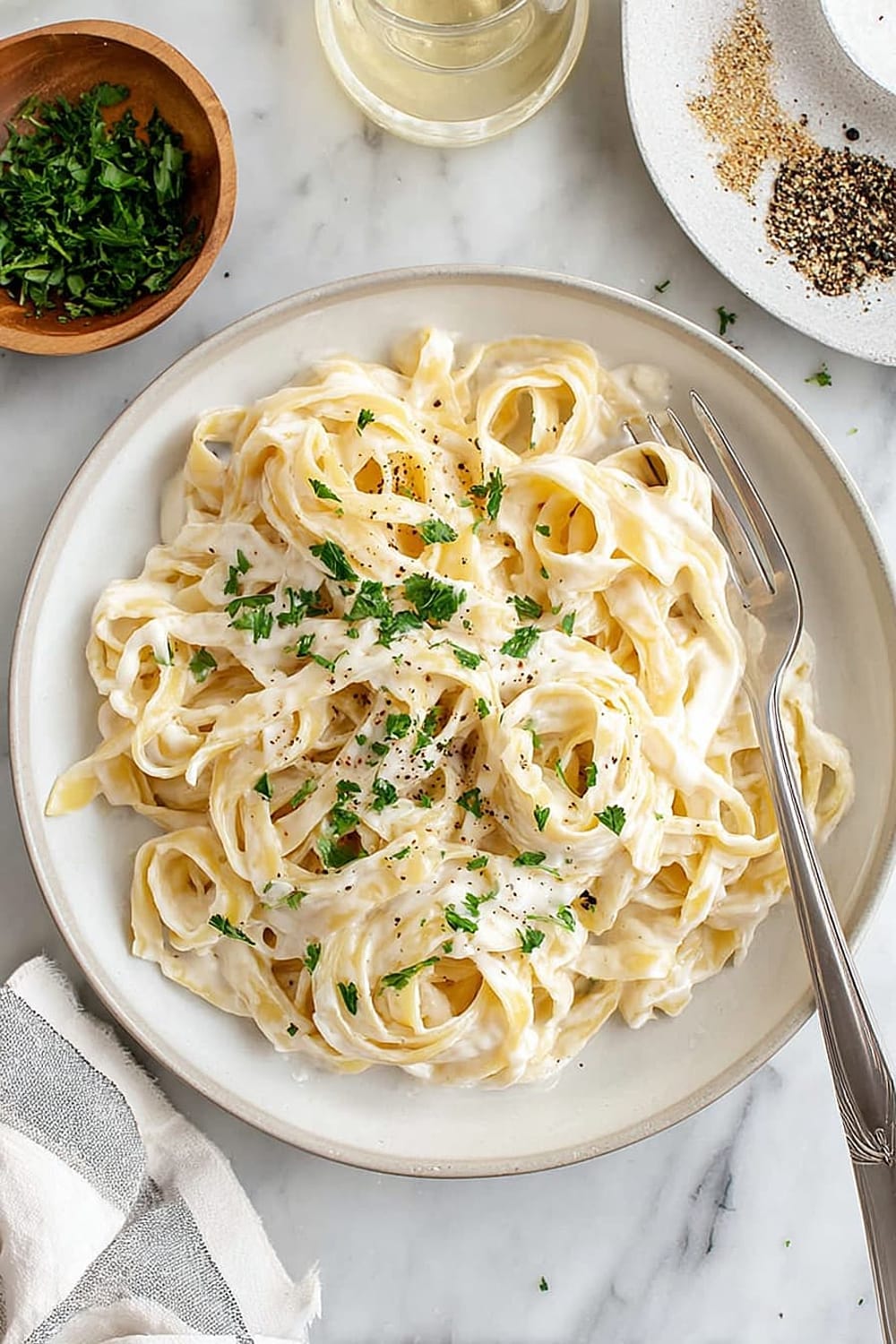
This lightened-up fettuccine Alfredo is about to become your secret weapon for looking like a culinary genius without the drama of traditional cream-heavy versions.
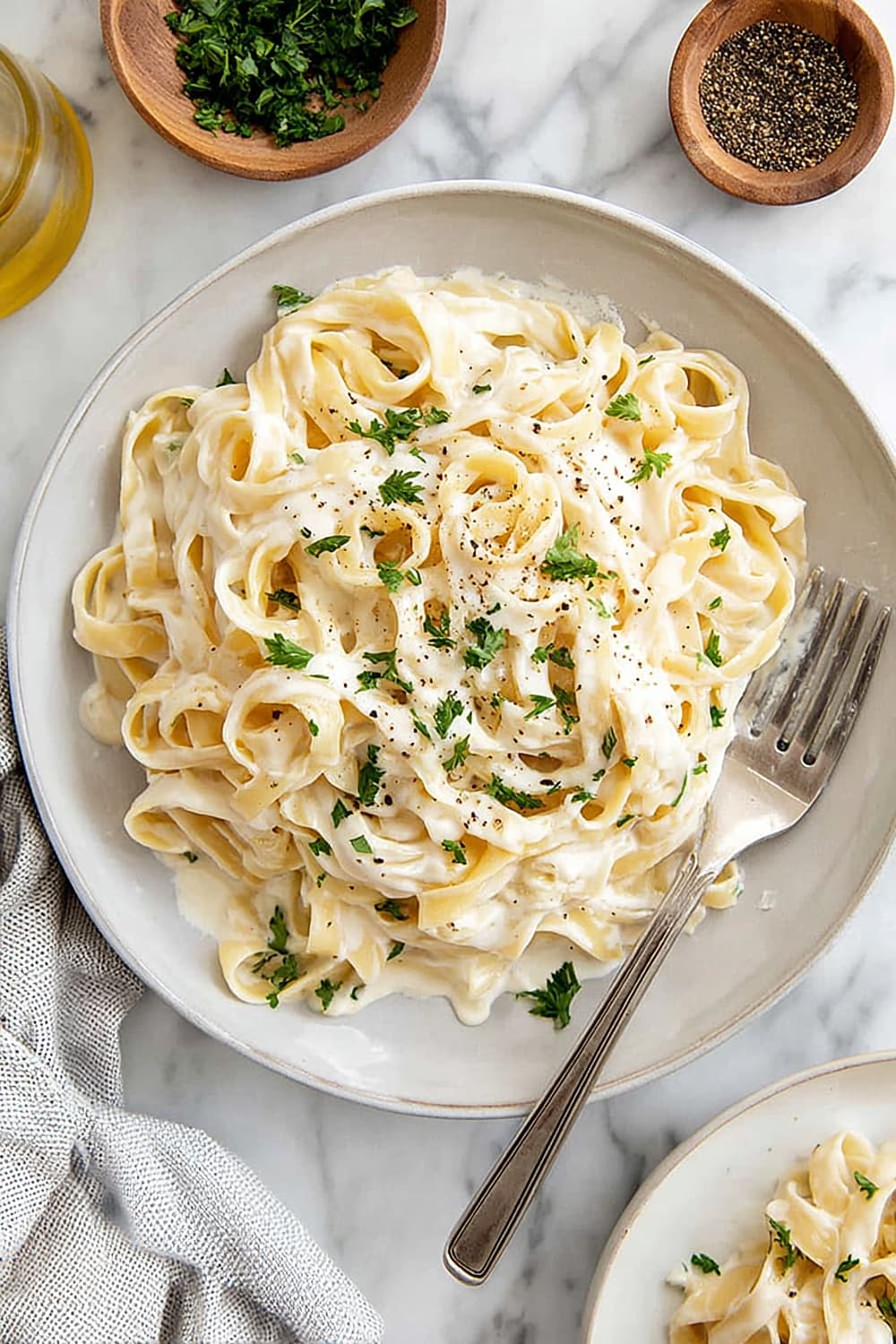
The magic happens when tender cauliflower transforms into the silkiest, most luxurious sauce that’ll have everyone convinced you spent hours perfecting some ancient Italian technique.
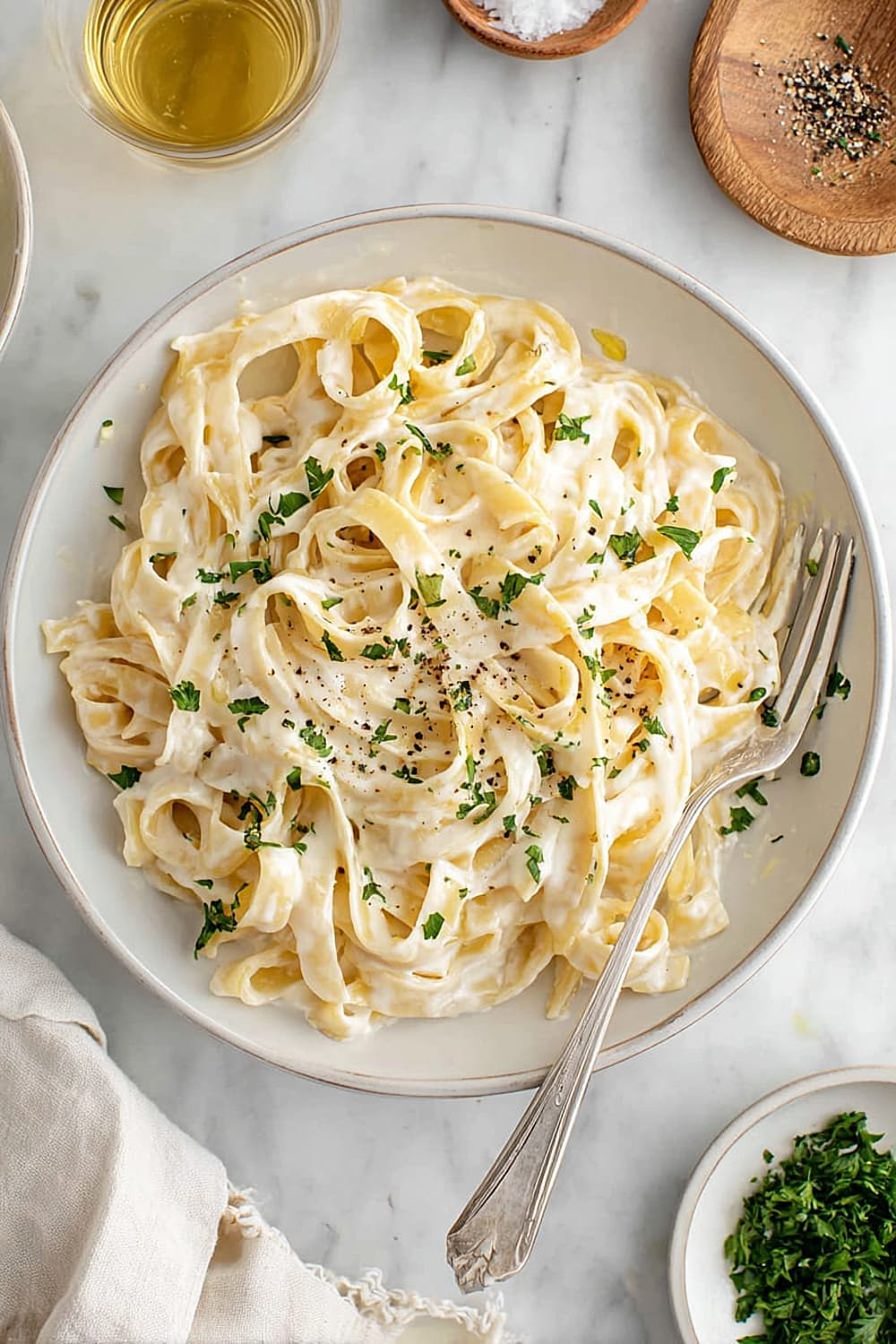
We’re talking restaurant-quality results with a fraction of the calories and none of the heavy, sluggish feeling that usually follows a bowl of traditional Alfredo.
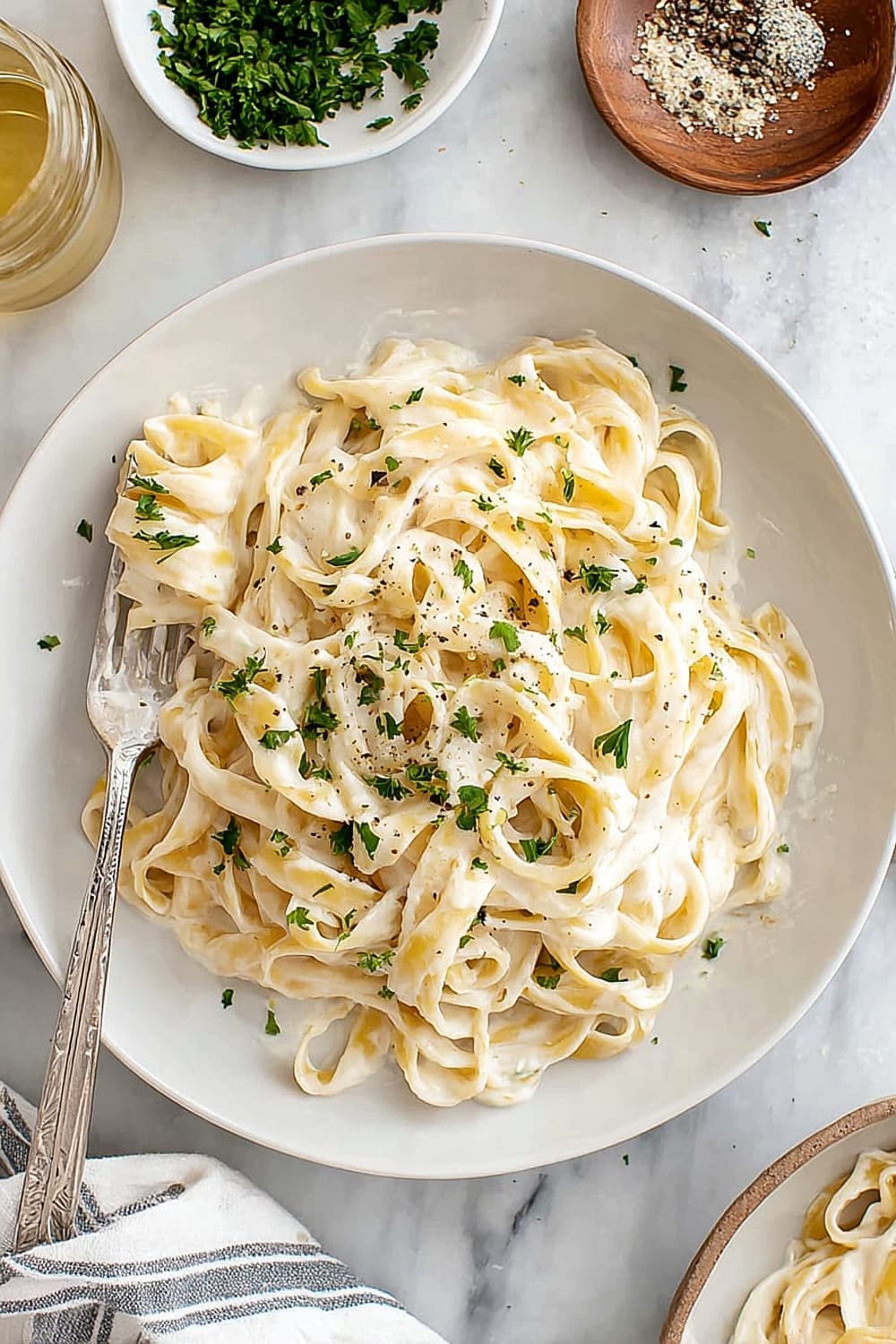
The genius lies in how the cauliflower completely disappears into this velvety dream sauce, adding creaminess and body while sneaking in extra vegetables like a nutritional ninja.
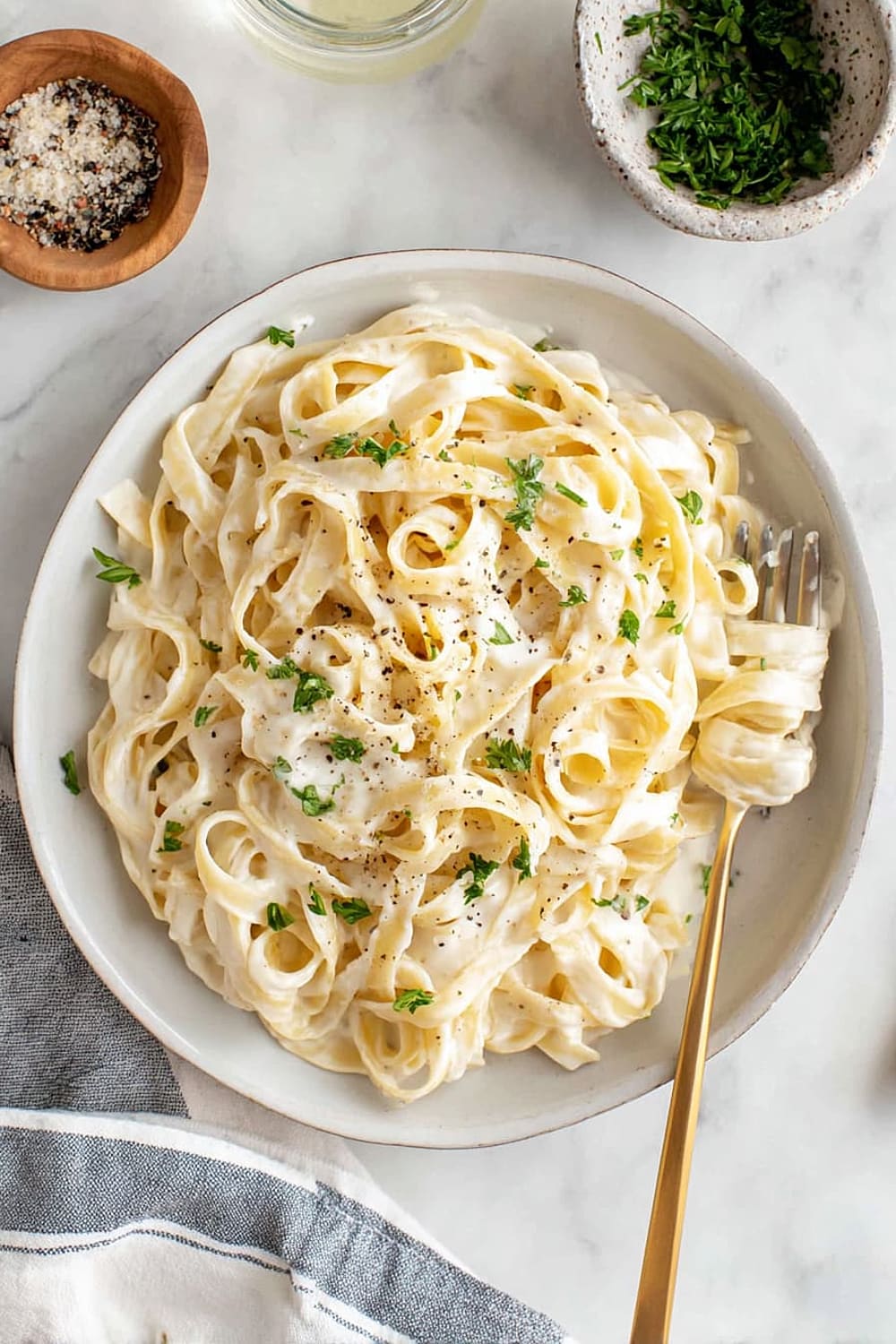
Your kitchen will smell like an Italian trattoria as garlic, butter, and Parmesan meld together with bright lemon juice and that secret cauliflower base.
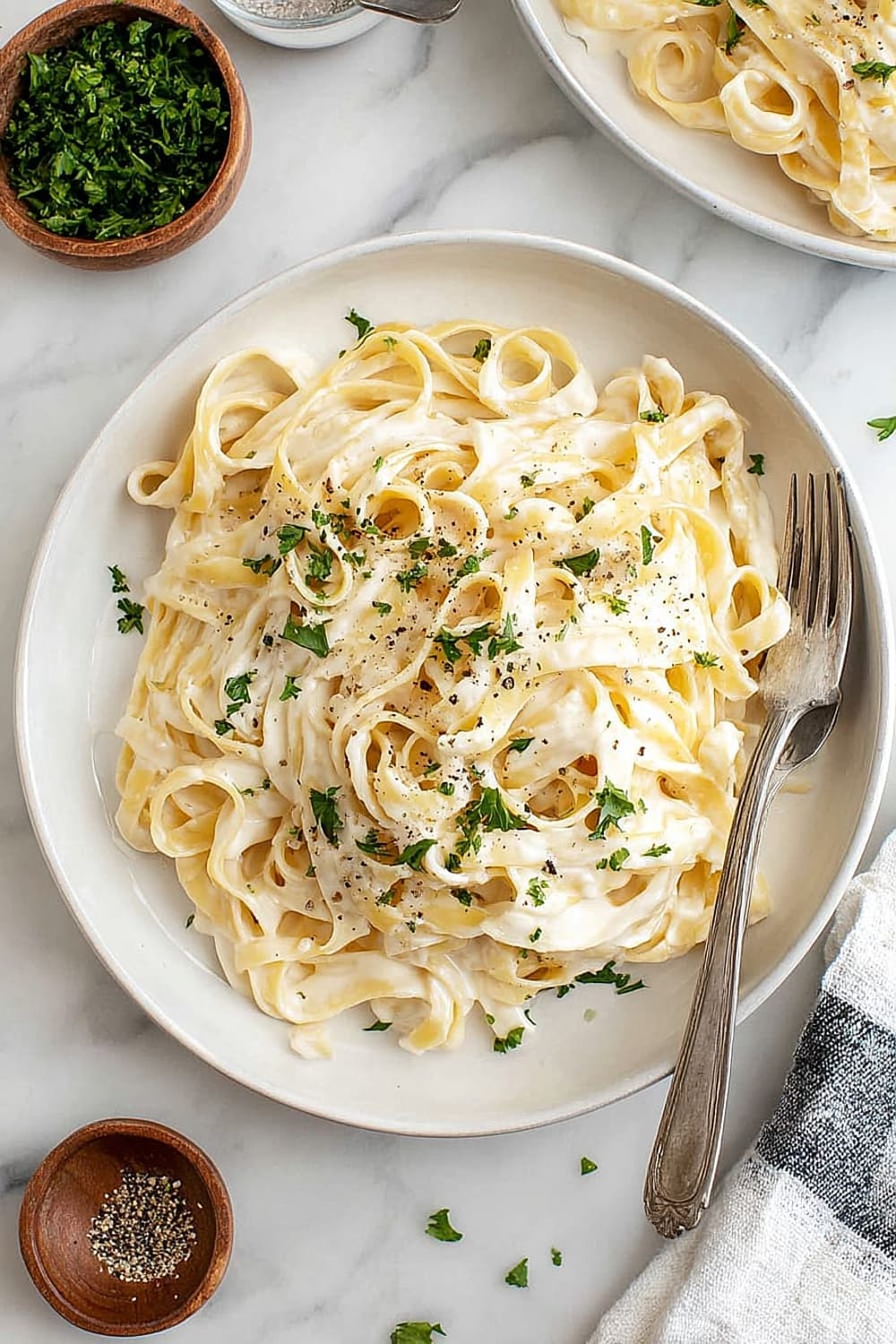
This is the kind of recipe that makes people lean back in their chairs with satisfied sighs and immediately ask for the recipe – which you can smugly share knowing it’s actually good for them.
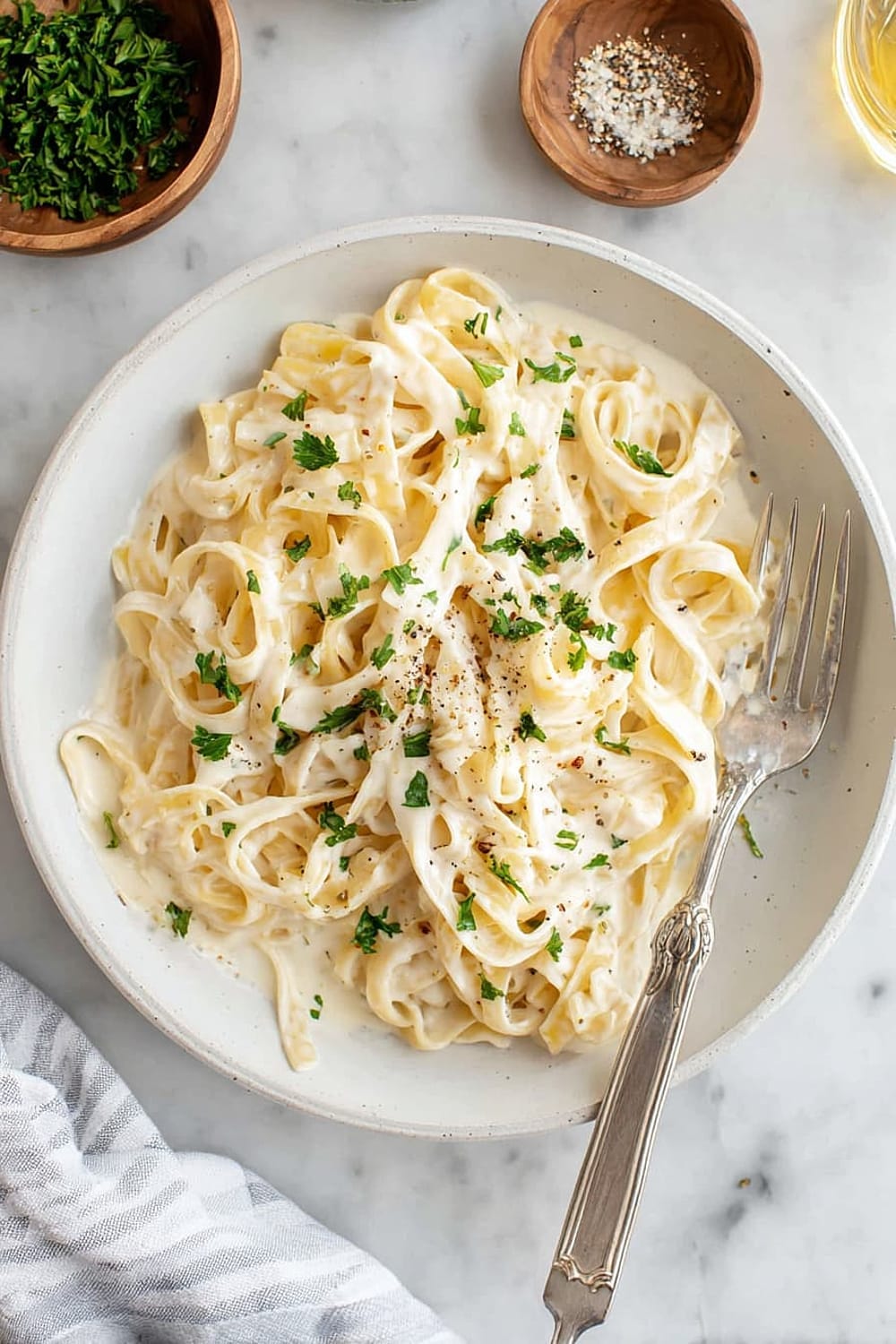
Ingredients
For the Cauliflower Sauce
- 12 ounces cauliflower florets (1 small cauliflower)
- ½ cup grated Parmesan cheese, plus more for serving
- ¼ cup extra-virgin olive oil
- 2 garlic cloves
- ½ teaspoon Dijon mustard
- 3 tablespoons unsalted butter
- 2 tablespoons fresh lemon juice
- 1 teaspoon sea salt
- Freshly ground black pepper
For the Pasta
- 16 ounces fettuccine pasta
- 1 to 1½ cups reserved pasta cooking water
- Chopped fresh parsley for garnish
Instructions
Prepare the Cauliflower Base
- 1 Bring a large pot of salted water to a rolling boil over high heat. The water should taste like mild seawater – this seasons the cauliflower from within and ensures maximum flavor absorption.
- 2 Add the 12 ounces cauliflower florets and boil until completely fork-tender, 8 to 10 minutes. The cauliflower should practically fall apart when pierced – this ensures the smoothest possible sauce texture.
- 3 Drain the cauliflower thoroughly and immediately transfer to a high-powered blender or food processor. Add the ½ cup Parmesan cheese, ¼ cup olive oil, 2 garlic cloves, ½ teaspoon Dijon mustard, 3 tablespoons butter, 2 tablespoons lemon juice, 1 teaspoon salt, and several generous grinds of black pepper.
Cook the Pasta
- 4 In the same large pot, bring fresh salted water to a boil and cook the 16 ounces fettuccine according to package directions until al dente. This typically takes 10-12 minutes, but start testing at 8 minutes for perfect texture.
- 5 Before draining, reserve 1½ cups of the starchy pasta cooking water – this liquid gold will help create the silky sauce consistency that makes Alfredo so irresistible.
Create the Sauce and Combine
- 6 Add 1 cup of the hot pasta water to the blender with the cauliflower mixture and blend until completely smooth and creamy, about 60-90 seconds. The sauce should be velvety and pale ivory in color.
- 7 Transfer the drained pasta to a large serving bowl or cast iron skillet. Pour the cauliflower Alfredo sauce over the pasta and toss vigorously to coat every strand.
- 8 If the sauce seems too thick, gradually add the remaining ½ cup pasta water, tossing continuously until you achieve that perfect clingy consistency that coats the pasta without being gluey.
Finish and Serve
- 9 Sprinkle with fresh chopped parsley and taste for seasoning, adding more salt and pepper as needed. Serve immediately with extra grated Parmesan cheese on the side for those who want an extra cheesy kick.
Recommended Equipment and Kitchen Tools
Essential Tools (for best results)
- High-powered blender or food processor – This is crucial for achieving that restaurant-smooth sauce texture that makes cauliflower completely disappear into silky perfection
- Large pasta pot with strainer insert – Makes reserving pasta water effortless and prevents the common mistake of forgetting to save that starchy liquid gold
- Digital kitchen scale – Measuring cauliflower by weight ensures consistent results every time, plus it’s more accurate than estimating floret sizes
- Microplane grater – Fresh-grated Parmesan melts infinitely better than pre-shredded cheese and creates a more luxurious sauce texture
Helpful Upgrades
- Cast iron skillet or large mixing bowl – Perfect for the final tossing stage, and cast iron retains heat to keep your pasta warm during serving
- Pasta fork or large tongs – Makes combining the sauce and pasta much easier than regular utensils, ensuring every strand gets properly coated
- Fine-mesh strainer – Useful for draining cauliflower thoroughly, which prevents watery sauce
Nice-to-Have Options
- Immersion blender – Can work as an alternative to a regular blender, though you might need to blend longer for ultra-smooth results
- Silicone spatula set – Perfect for scraping every bit of that precious sauce from the blender
Recipe Variations and Dietary Modifications
Gluten-Free Adaptation
- Replace fettuccine with gluten-free pasta made from rice, corn, or legumes – use same cooking method but check package directions as cooking times vary
- Shirataki noodles work brilliantly for ultra-low-carb version, just rinse and dry them thoroughly before adding sauce
- Zucchini noodles create a completely vegetable-based dish – spiralize 4-5 large zucchini and sauté briefly before tossing with sauce
Dairy-Free Modifications
- Substitute Parmesan with nutritional yeast (start with ¼ cup and adjust to taste) for cheesy flavor without dairy
- Replace butter with additional olive oil or vegan butter for richness
- Add 1 tablespoon tahini or cashew cream for extra creaminess and depth
Protein Additions
- Grilled chicken breast (sliced) – season with Italian herbs and add during final tossing
- Sautéed shrimp – cook with garlic and red pepper flakes for complementary flavors
- Pan-seared scallops – their sweetness pairs beautifully with the lemony sauce
- Crispy pancetta or bacon – adds smoky richness that balances the light cauliflower base
Vegetable Variations
- Roasted broccoli or asparagus – roast at 425°F until crispy-tender and fold in before serving
- Sautéed mushrooms – use cremini or shiitake for earthy depth
- Sun-dried tomatoes – adds tangy sweetness and beautiful color contrast
Nutritional Information and Health Benefits
Key Nutritional Highlights
This lightened-up version delivers approximately 420 calories per serving compared to traditional Alfredo’s 800+ calories, while providing 15 grams protein, 8 grams fiber, and significant amounts of vitamin C, vitamin K, and folate from the cauliflower base. The recipe serves 4-6 people generously, making each portion a reasonable indulgence that won’t derail healthy eating goals.
Health Benefits of Main Ingredients
Cauliflower provides powerful antioxidants including choline for brain health and sulforaphane compounds that support detoxification processes. The Parmesan cheese contributes high-quality protein and calcium for bone health, while extra-virgin olive oil delivers heart-healthy monounsaturated fats and vitamin E. Fresh lemon juice adds vitamin C and helps with iron absorption from the pasta, plus the citric acid aids in maintaining the sauce’s bright color and fresh flavor.
Dietary Considerations
This recipe contains gluten from wheat pasta and dairy from cheese and butter, but both can be easily substituted. The dish is naturally vegetarian and provides a good balance of carbohydrates, healthy fats, and protein. Each serving contains approximately 45 grams carbohydrates, making it suitable for most balanced eating plans when paired with a simple salad or steamed vegetables.
Smart Swaps and Ingredient Substitutions
Common Substitutions:
- Cauliflower florets → Steamed white beans or silken tofu for different creamy base options
- Fettuccine pasta → Linguine, pappardelle, or even spaghetti work perfectly with this sauce consistency
- Fresh lemon juice → White wine vinegar or apple cider vinegar (use half the amount for less acidity)
- Dijon mustard → Whole grain mustard or even a pinch of garlic powder for depth
Budget-Friendly Swaps:
- Fresh Parmesan → Pre-grated Parmesan (though texture won’t be quite as smooth) or aged white cheddar
- Extra-virgin olive oil → Regular olive oil or even avocado oil for neutral flavor
- Unsalted butter → Salted butter (just reduce the added salt accordingly)
Pantry Emergency Substitutions:
- Fresh garlic → 1 teaspoon garlic powder or granulated garlic
- Fresh parsley → Dried Italian seasoning, fresh basil, or even chives for color and freshness
- Sea salt → Regular table salt or kosher salt work perfectly
Pro Tips for Substitutions:
- When using frozen cauliflower, thaw and drain thoroughly before cooking to prevent watery sauce
- If substituting pasta shapes, choose ones with ridges or curves that grab onto the creamy sauce effectively
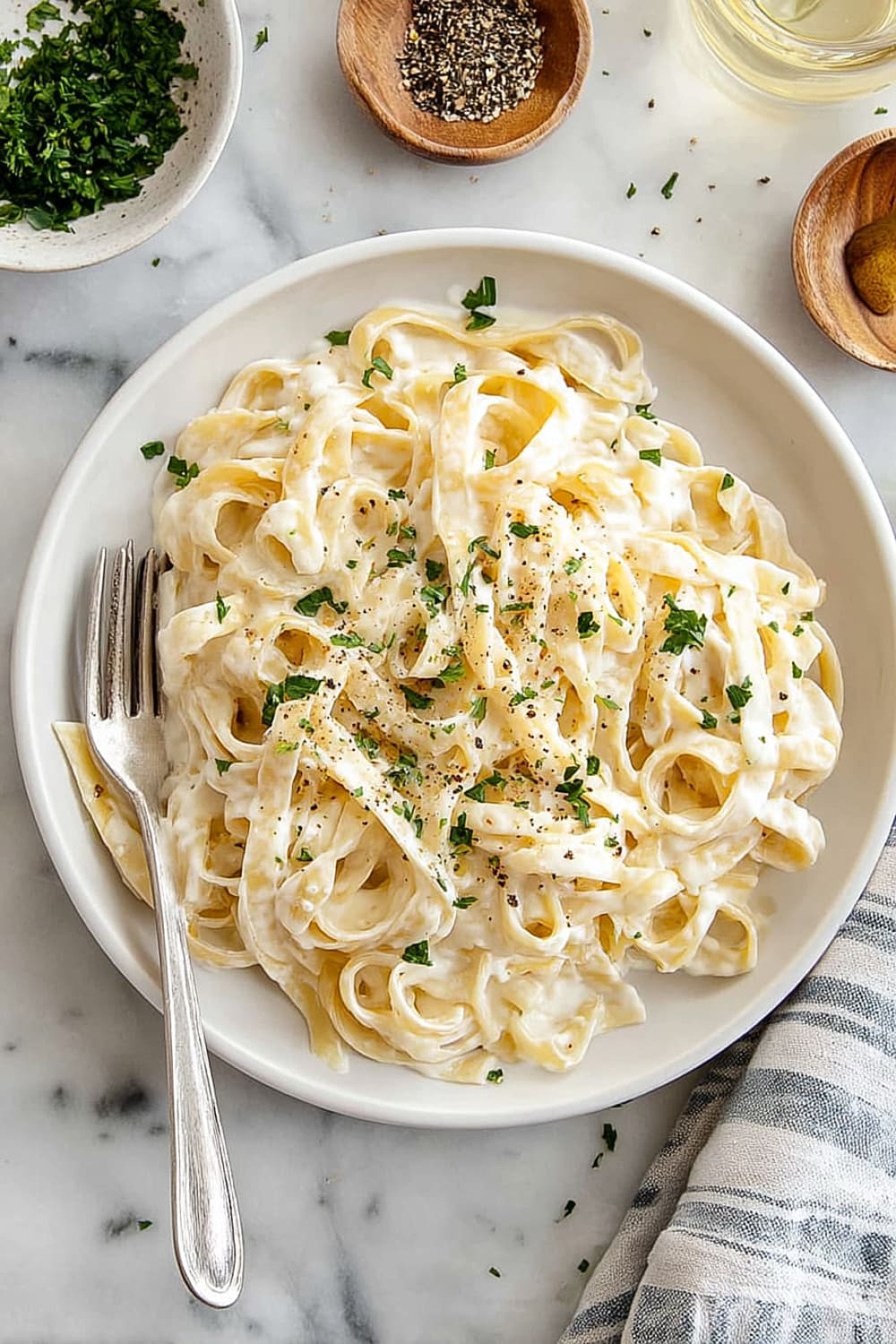
Make It Diabetes-Friendly
Carb Reduction Strategies:
- Replace half the pasta with spiralized zucchini or spaghetti squash to reduce carbs by approximately 25 grams per serving
- Use shirataki noodles entirely for only 5 grams carbs per serving versus 45 grams in regular pasta
- Serve smaller pasta portions (2-3 ounces per person) over a bed of roasted vegetables
Portion & Timing Tips:
- Ideal serving size: ¾ cup pasta with sauce provides approximately 35 grams carbohydrates
- Pair with protein: Add grilled chicken or salmon to slow carbohydrate absorption and improve blood sugar response
- Include fiber: Serve alongside a large mixed green salad with olive oil dressing to further moderate blood sugar impact
- Timing strategy: Best consumed as lunch or early dinner when insulin sensitivity is typically higher
Blood Sugar Friendly Additions:
- Extra vegetables: Double the cauliflower and add broccoli or asparagus for more fiber and nutrients
- Healthy fats: The olive oil and butter actually help slow digestion and moderate blood sugar spikes
- Protein boost: Stir in cooked white beans or lentils for plant-based protein and additional fiber
Total Carb Reduction: These modifications can reduce carbs from 45 grams to 15-20 grams per serving while maintaining satisfaction and flavor.
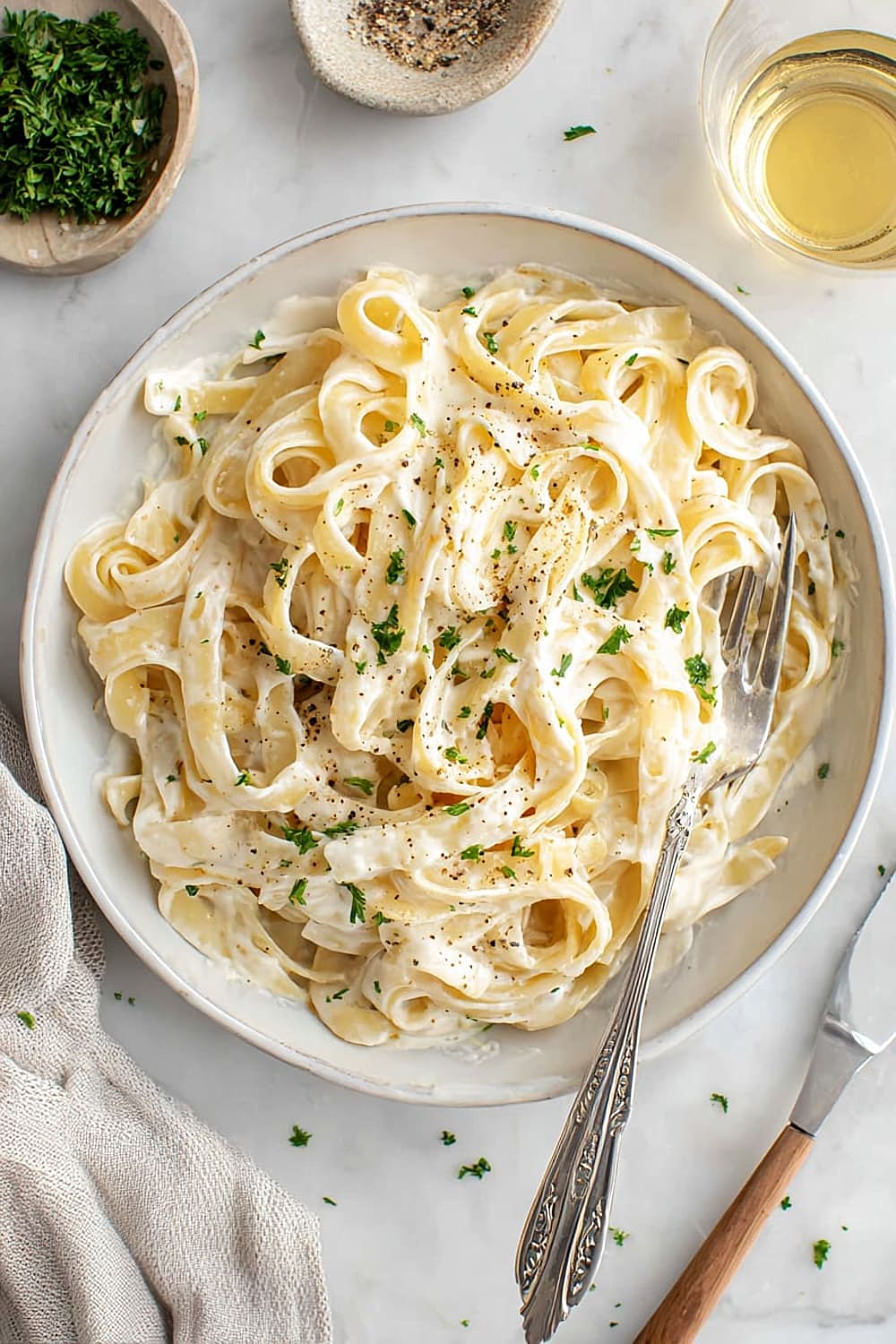
Perfect Pairing Suggestions
Beverage Pairings
A crisp Pinot Grigio or Sauvignon Blanc cuts through the richness while complementing the lemon brightness, while Chardonnay matches the creamy texture beautifully. For non-alcoholic options, sparkling water with lemon or iced green tea provide palate-cleansing qualities. Light Italian sodas or kombucha add effervescence that balances the dish’s richness.
Side Dish Recommendations
Arugula salad with balsamic vinaigrette provides peppery contrast to the mild, creamy pasta, while roasted Brussels sprouts with pancetta adds textural variety and complementary flavors. Garlic bread made with whole grain bread satisfies traditional expectations, and steamed broccoli with lemon doubles down on the vegetable theme while adding vibrant color and crunch.
Complete Meal Ideas
Start with antipasto skewers featuring cherry tomatoes, mozzarella, and basil, then follow the pasta with herb-crusted salmon or grilled chicken thighs. For dessert, lemon panna cotta or fresh berries with whipped cream continues the light, bright theme without overwhelming the palate.
Occasion Suggestions
Perfect for weeknight family dinners when you want something special but achievable, casual entertaining where the healthy twist becomes a conversation starter, or meal prep since it reheats beautifully for work lunches throughout the week.
Pro Tips and Troubleshooting
Professional Techniques
Salt your pasta water generously – it should taste like seawater to properly season the noodles from within. Save extra pasta water beyond what the recipe calls for; its starchy content is your secret weapon for adjusting sauce consistency even after serving. Blend the sauce while hot for the smoothest texture, and don’t skip the Dijon mustard – it acts as an emulsifier that prevents the sauce from separating.
Common Mistake Prevention
Never drain cauliflower incompletely – excess water creates thin, disappointing sauce. Don’t skip reserving pasta water – regular water won’t create the same silky consistency. Avoid over-blending once you add pasta water, which can make the sauce gluey rather than creamy.
Storage and Reheating
Refrigerate leftovers up to 3 days in airtight containers. Reheat gently with a splash of milk or pasta water to restore creaminess, stirring frequently over low heat. Freeze portions up to 2 months, though the texture may be slightly less smooth after thawing.
Make-Ahead Strategy
Prepare the cauliflower sauce 2 days ahead and refrigerate. Cook pasta fresh when ready to serve for best texture, then combine with rewarmed sauce.
This cauliflower Alfredo proves that comfort food can be both indulgent and nourishing, delivering all the satisfaction of traditional pasta dishes while sneaking in extra vegetables and cutting calories in half. The beauty lies in how completely the cauliflower disappears, creating a sauce so rich and luxurious that even the most dedicated cream-sauce lovers won’t miss the heavy dairy – they’ll just keep asking for your secret to making Alfredo taste so incredibly fresh and light.